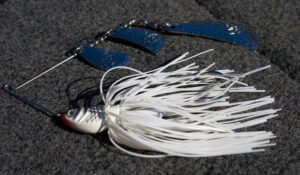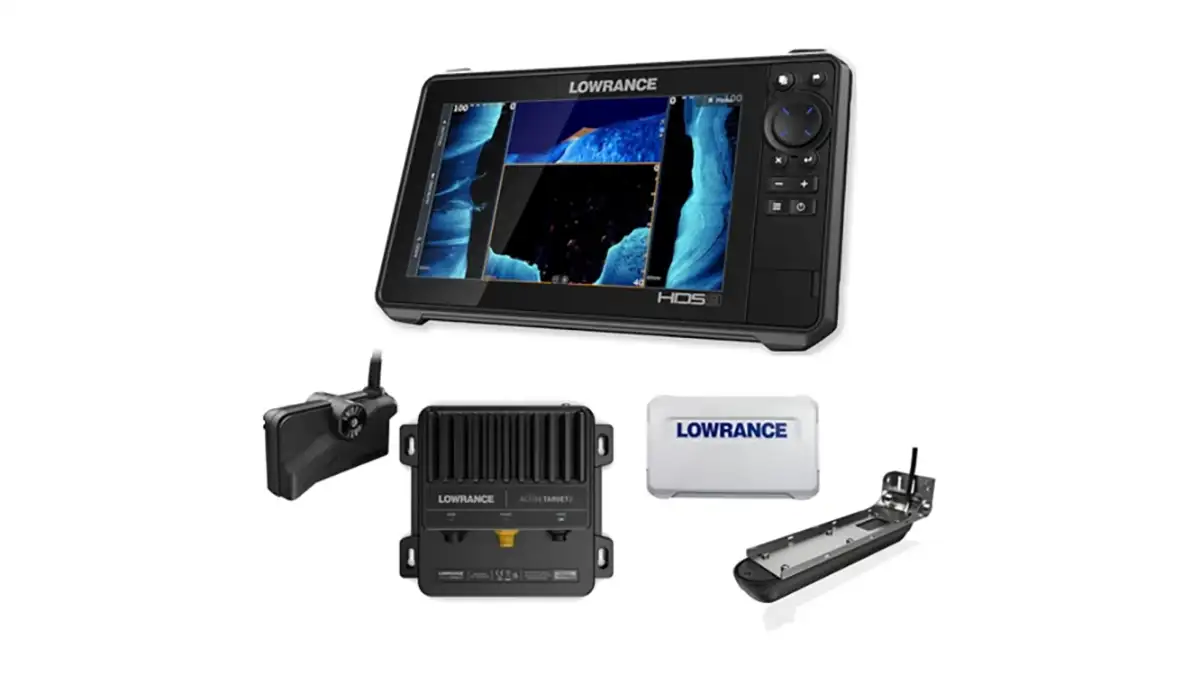Spinnerbait blade selection is something that has baffled many bass anglers for years. If you walk down the aisles of your favorite tackle store, you’re sure to see enough blade combinations to make your head spin. While different blade combinations will certainly work in various conditions, there is a method to the madness according to Vicious Fishing pro Marty Stone.
Stone has developed very specific preferences when it comes to blade selection and has caught countless big bass using this system. Regardless of water clarity and weather, there is never a doubt in his mind when it comes to selecting the proper spinnerbait blade combination.
Single blade
Stone reaches for his single blade spinnerbaits in two situations—when night fishing or targeting prespawn bass. Although he’ll change the blade size and spinnerbait weight to accommodate specific conditions, he believes that a single blade is the way to go in these conditions.
When he finds himself on the water after dark, Stone instinctively turns to a 1/2-ounce black spinnerbait with a gold No. 6 Colorado blade. As the bass’ nighttime vision is significantly inhibited, a big Colorado blade allows them to sense the intense vibrations with their lateral lines.
“A big no. 6 Colorado blade is the only blade you need to throw when you’re night fishing,” Stone said. “It causes all kinds of vibration underwater and the bass really seem to hone in on the massive water displacement caused by a big, single Colorado blade.”
To coax these nighttime bass into eating, he likes to slowly fish it close to the bottom of the water column. Stone’s not afraid to slow his presentation down to a crawl, either, as he catches many of his biggest bass while slowly dragging the big spinnerbait around isolated cover.
An equally effective application for single-bladed spinnerbaits is during cloudy prespawn days. In this situation, Stone tempts the bass with a 3/4-ounce spinnerbait paired with a no. 7 Colorado blade. Although effective, a few specific variables have to be in place in order to maximize his effectiveness.
“There has to be hydrilla and flooded cover, such as willows and buck brush, present,” Stone said. “I wish I could say why, but I truthfully don’t know. After all the fishing I’ve done, I’ve pieced things together and it’s just lights-out under these conditions.”
Whenever conditions call for a single-bladed spinnerbait, Stone likes to beef up his tackle a bit in order to counteract the heavier spinnerbait. For added strength, he prefers 20-pound monofilament line with a 7-foot, medium-heavy action rod. When a big bass bites, the stout gear gives him the confidence to get the fish into the boat.
Double blades
As with any technique, a number of conditions dictate when and where Stone utilizes double-bladed spinnerbaits. Although several variables come into play, water temperature is his main focus when selecting a spinnerbait with double blades.
In stained water below 55-degrees, stone prefers a 1/2-ounce spinnerbait with no. 3 and no. 4 1/2 Colorado blades. Again, in low-visibility conditions, bass need something, such as a big vibration, to help them hone in on the bait. Stone believes the no. 4 1/2 Colorado blades to be absolutely essential in these situations.
“The biggest mistake I see people make when spinnerbait fishing in cold water is winding the bait too fast, causing the bait to rise too high in the water column” Stone said. “In cold water, you want both Colorado blades to be entirely out of sight. When you’ve got that, you know you have the right retrieve speed.”
As the water warms to between 55- and 60-degrees, the large majority of Stone’s spinnerbait success comes on a Colorado and willow leaf combination. As the shad become more active in this temperature range, the willow leaf blade lets Stone significantly increase his retrieve speed while also effectively emulating a small shad.
While he does, in fact, fish a spinnerbait faster in these conditions, Stone still keeps a watchful eye on the bait. In order to increase his number of bites, he doesn’t want to see the blades. Because some bass may remain a bit hesitant in this temperature range, Stone aims to keep his spinnerbait in the strike zone for as long as possible.
Whenever the early morning water temperature rises to 65-degrees, Stone has one thing on his mind—shad. To target bass gorging on plentiful populations of shad, he uses twin willow leaf blades. With the decreased water displacement of willow blades, Stone is able to burn his spinnerbait to imitate fleeing shad. As the two previous double blade combinations are meant to target both a bass’ sense of feel and sight, Stone believes a double willow leaf combination to be solely a “sight” presentation for bass.
“I primarily throw a twin willow leaf spinnerbait throughout both the shad spawn and post spawn,” Stone said. “Points and rip rap are major hotspots in these conditions, and water clarity doesn’t seem to matter as much. If you get around a lot of shad in this water temperature range, the bass will try to take your rod from you.”
Triple blades
Every angler has superior confidence in a couple of specific baits, and Marty Stone is no different. When the money is on the line, you won’t be hard-pressed to find a triple hatchet blade spinnerbait on his front deck. A totally different look for most highly pressured bass, hatchet blades create a unique thumping vibration in the water while also maintaining the subtlety of willow leaf blades.
Stone throws a spinnerbait with triple hatchet blades in two conditions—the first thing in the morning on a sunny day or all day in nasty, rainy conditions. Come to think of it, that’s pretty much most of the time, right?
“I am absolutely convinced that triple hatchet blades catch more spinnerbait fish than any other blade you could possible use,” Stone said. “I’m not sure if it’s because the bass don’t see them as often or because I have so much confidence in them, but I’m telling you—they work.”
Selecting the proper spinnerbait blade combinations can be pretty tough and requires a lot of trial and error. Patience is key, however, and if you keep an open mind and make it a point to experiment with different combinations in various conditions, you’ll soon have a concrete, failsafe system just like the pros.















